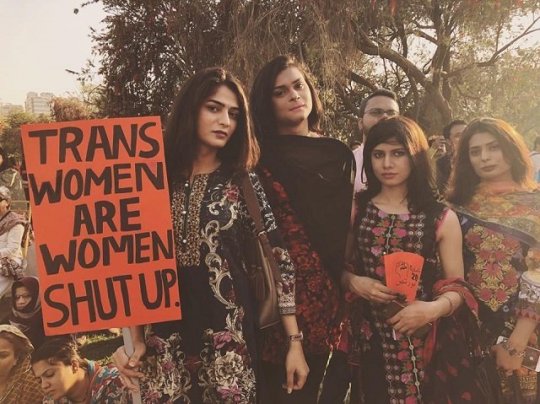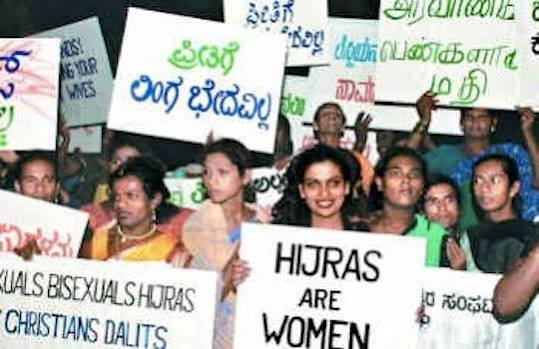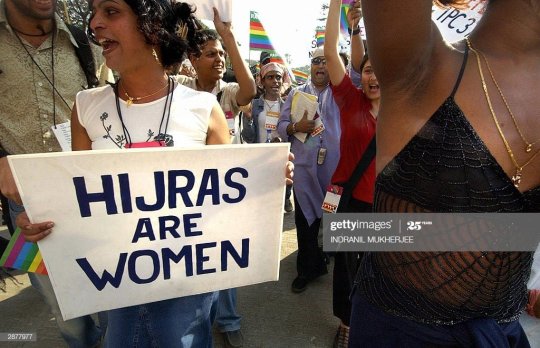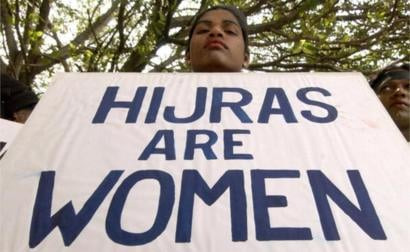#femminielli
Text

I think about this image a lot. This is an image from the Aurat March (Women's March) in Karachi, Pakistan, on International Women's Day 2018. The women in the picture are Pakistani trans women, aka khwaja siras or hijras; one is a friend of a close friend of mine.
In the eyes of the Pakistani government and anthropologists, they're a "third gender." They're denied access to many resources that are available to cis women. Trans women in Pakistan didn't decide to be third-gendered; cis people force it on them whether they like it or not.

Western anthropologists are keen on seeing non-Western trans women as culturally constructed third genders, "neither male nor female," and often contrast them (a "legitimate" third gender accepted in its culture) with Western trans women (horrific parodies of female stereotypes).
There's a lot of smoke and mirrors and jargon used to obscure the fact that while each culture's trans women are treated as a single culturally constructed identity separate from all other trans women, cis women are treated as a universal category that can just be called "women."

Even though Pakistani aurat and German Frauen and Guatemalan mujer will generally lead extraordinarily different lives due to the differences in culture, they are universally recognized as women.

The transmisogynist will say, "Yes, but we can't ignore the way gender is culturally constructed, and hijras aren't trans women, they're a third gender. Now let's worry less about trans people and more about the rights of women in Burkina Faso."

In other words, to the transmisogynist, all cis women are women, and all trans women are something else.

"But Kat, you're not Indian or Pakistani. You're not a hijra or khwaja sira, why is this so important to you?"
Have you ever heard of the Neapolitan third gender "femminiello"? It's the term my moniker "The Femme in Yellow" is derived from, and yes, I'm Neapolitan. Shut up.
I'm going to tell you a little bit about the femminielli, and I want you to see if any of this sounds familiar. Femminielli are a third gender in Neapolitan culture of people assigned male at birth who have a feminine gender expression.
They are lauded and respected in the local culture, considered to be good omens and bringers of good luck. At festivals you'd bring a femminiello with you to go gambling, and often they would be brought in to give blessings to newborns. Noticing anything familiar yet?
Oh and also they were largely relegated to begging and sex work and were not allowed to be educated and many were homeless and lived in the back alleys of Naples, but you know we don't really like to mention that part because it sounds a lot less romantic and mystical.
And if you're sitting there, asking yourself why a an accurate description of femminiello sounds almost note for note like the same way hijras get described and talked about, then you can start to understand why that picture at the start of this post has so much meaning for me.
And you can also start to understand why I get so frustrated when I see other queer people buy into this fool notion that for some reason the transes from different cultures must never mix.
That friend I mentioned earlier is a white American trans woman. She spent years living in India, and as I recal the story the family she was staying with saw her as a white, foreign hijra and she was asked to use her magic hijra powers to bless the house she was staying in.
So when it comes to various cultural trans identities there are two ways we can look at this. We can look at things from a standpoint of expressed identity, in which case we have to preferentially choose to translate one word for the local word, or to leave it untranslated.
If we translate it, people will say we're artificially imposing an outside category (so long as it's not cis people, that's fine). If we don't, what we're implying, is that this concept doesn't exist in the target language, which suggests that it's fundamentally a different thing
A concrete example is that Serena Nanda in her 1990 and 2000 books, bent over backwards to say that Hijras are categorically NOT trans women. Lots of them are!

And Don Kulick bent over backwards in his 1998 book to say that travesti are categorically NOT trans women, even though some of the ones he cited were then and are now trans women.
The other option, is to look at practice, and talk about a community of practice of people who are AMAB, who wear women's clothing, take women's names, fulfill women's social roles, use women's language and mannerisms, etc WITHIN THEIR OWN CULTURAL CONTEXT.
This community of practice, whatever we want to call it - trans woman, hijra, transfeminine, femminiello, fairy, queen, to name just a few - can then be seen to CLEARLY be trans-national and trans-cultural in a way that is not clearly evident in the other way of looking at things.
And this is important, in my mind, because it is this axis of similarity that is serving as the basis for a growing transnational transgender rights movement, particularly in South Asia. It's why you see pictures like this one taken at the 2018 Aurat March in Karachi, Pakistan.
And it also groups rather than splits, pointing out not only points of continuity in the practices of western trans women and fa'afafines, but also between trans women in South Asia outside the hijra community, and members of the hijra community both trans women and not.
To be blunt, I'm not all that interested in the word trans woman, or the word hijra. I'm not interested in the word femminiello or the word fa'afafine.
I'm interested in the fact that when I visit India, and I meet hijras (or trans women, self-expressed) and I say I'm a trans woman, we suddenly sit together, talk about life, they ask to see American hormones and compare them to Indian hormones.
There is a shared community of practice that creates a bond between us that cis people don't have. That's not to say that we all have the exact same internal sense of self, but for the most part, we belong to the same community of practice based on life histories and behavior.
I think that's something cis people have absolutely missed - largely in an effort to artificially isolate trans women. This practice of arguing about whether a particular "third gender" label = trans women or not, also tends to artificially homogenize trans women as a group.
You see this in Kulick and Nanda, where if you read them, you could be forgiven for thinking all American trans women are white, middle class, middle-aged, and college-educated, who all follow rigid codes of behavior and surgical schedules prescribed by male physicians.
There are trans women who think of themselves as separate from cis women, as literally another kind of thing, there are trans women who think of themselves as coterminous with cis women, there are trans women who think of themselves as anything under the sun you want to imagine.
The problem is that historically, cis people have gone to tremendous lengths to destroy points of continuity in the transgender community (see everything I've cited and more), and particularly this has been an exercise in transmisogyny of grotesque levels.
The question is do you want to talk about culturally different ways of being trans, or do you want to try to create as many neatly-boxed third genders as you can to prop up transphobic theoretical frameworks? To date, people have done the latter. I'm interested in the former.
I guess what I'm really trying to say with all of this is that we're all family y'all.
#transgender#third gender#hijras#femminielli#trans women are women#trans solidarity#trans rights#transmisogyny#transunity#transunitism#this is what trans unity looks like
7K notes
·
View notes
Text
[Uvaspina][Monica Acito]
Uvaspina, il femminiello, sensibile e fragile. Minuccia, la sorella, feroce fino alla crudeltà. Un legame che rischia di diventare una prigione. Antonio, il pescatore che ama leggere. Amore, gelosia, rinascita, disperazione in un romanzo d’esordio
È nato con una voglia sotto l’occhio sinistro, come un pallido frutto incastonato nella pelle: Uvaspina si è abituato presto a essere chiamato con quel nome che lo identifica con la sua macchia. A quasi tutto, del resto, è capace di abituarsi: a suo padre, il notaio Pasquale Riccio, che si vergogna di lui; alla Spaiata, sua madre, che dopo aver incastrato Pasquale Riccio con le sue arti di…

View On WordPress
#2023#Bompiani#femminielli#fiction#Italia#LGBT#LGBTQ#Monica Acito#Narrativa#narrativa italiana#Premio Calvino#Uvaspina
0 notes
Text

Il femminiello by Giuseppe Bonito (mid 18th century)
The femminielli are a population of third-gender people in traditional Neapolitan culture. While many try and fit them into being either 'feminine gay men' or 'transgender women', the femminielli are best understood by their own unique history and actions. As gender is a social construct, some genders are specific to specific societies, and can't easily be transposed onto other terms!
185 notes
·
View notes
Text
Highlighting LGBTQIA+ spiritual traditions.
youtube
This is from Candelora 2023, held at the Sanctuary of Montevergine in Avellino, Italy in honor and invocation of Mama Schiavona who protects the Femminielli. The Femminielli are their own gender, native to what is now Southern Italy. They bring good luck and have been a part of the sacred landscape of Southern Italy for pretty much all of recorded history. Naples itself never historically persecuted homosexuality, even when many other parts of Europe did the opposite.
In addition to Candelora, the Femminielli also participate in the feast of la Madonna dell'Arco and the Easter Monday tradition of the matrimonio dei femminielli--a magnificent ritual wedding celebration.
There are some very old non-binary genders in this world, particularly around the Mediterranean. Some Femminielli may identify as Trans Women while others may not. Gender is complicated. The Femminielli serve a vital spiritual role to the religious hygiene of their communities. Bringing good luck, joy, and blessings to all from the depths of time itself.
In the video, I think I hear the familiar voice of Roberto de Simone--the very same musical legend responsible for the Neapolitan Opera, "La Gatta Cenerentola," which also features Femminielli in the cast. I did a dive on that one a while back. You can also see musicians gathering to sing and drum for Mama Schiavona. The music they are singing for her is a Tammurriata. Tammurriata refers to the rhythm as well as the dance of the same name that goes with it. The giant tambourine you see in this video is called a tammorra and that rhythm is absolutely ancient.
These are extremely devout lay people who are performing this invocation. They have processed here through the city to the sanctuary and this is just how it is done. They have come to pray for protection of the marginalized and to celebrate everything Mama Schiavona and the Femminielli stand for. This is what folk religion looks like.
205 notes
·
View notes
Text
Today's queer saint of the day is Our Lady of Montevirgene, the miracle of 1256, and the Juta dei Femminielli.

This is one of those things where you start researching it and immediately go "whoa! EVERYONE needs to know about this!" It is something that is (unfortunately) extremely rare in Christianity: a venerable and explicit celebration of queerness, and specifically transfeminine identity.
The abbey of Montevirgene, near Naples in Italy, was built in the 1100s on top of the ruins of a temple to Cybele or Magna Mater, an ancient earth goddess who was (and still is) served by transfeminine priestesses called gallae. The local people fully accept that early Christian missionaries identified Cybele with Mary in order to encourage conversion, and they do not see any conflict in it. Whether it's Cybele or Mary, there is a divine presence on Montevirgene, and it is a divine presence that loves and protects queer and trans people in particular.
According to the legend, in AD 1256, a young queer couple was being persecuted by their community. They were stripped, beaten, and left for dead on top of the hill in the middle of winter. Moved by their plight, the Madonna warmed them with a ray of sunshine, and they survived. The community accepted this as a miracle, and let the young couple return in peace. Ever since then, the miracle has been commemorated with a grand procession and celebration on Candelora or Candlemass (February 2). Part of this celebration involves the "Juta dei Femminielli," which I have mostly seen translated into English as the "March of the Transsexuals."
Femminielli are actually a culturally-specific transfeminine identity that doesn't translate neatly into English, and they are an ancient community of people who pre-date modern notions of gender identity and sexual orientation. Dancing, singing, drumming, and wearing fun costumes, they lead the pilgrimage up the hill to the abbey, where Mass is celebrated and the pilgrims venerate the icon of the Madonna. It has been called "the world's oldest Pride parade."
There is some conflict between the pilgrims and the abbey, but that too seems like part of the performance: almost an acknowledgment of the tension between the pleasant organic weirdness of "folk" Christianity and the dour, patriarchal, no-fun-allowed institutional Church. However, if the abbey really didn't want the pilgrims there, they had 800 years to suppress them, and the pilgrimage continues with the agreement that they will not disturb the celebration of the Mass. After all, the pilgrims are also devoted Roman Catholics, and they respect the sanctity of the sacraments. It is a celebration of the meeting between the sacred and profane, heaven and earth, masculine and feminine, and it does not appear to be going away any time soon.
If you want to know more about this apparition and the pilgrimage, I recommend this 23-minute documentary
There is also a Qspirit entry and a website to promote the pilgrimage
45 notes
·
View notes
Text
Gender neutral in Italian: It’s messy.
Introduction
Since I was given the “keep it basic” answer when I said I don’t know how to refer to someone in a gender-neutral way in Italian, I decided to do a little digging, mainly on Reddit as forums are extremely useful and a good resource when you have a question about someone else’s culture, since you’re likely to get answers from people who live there
But before we go into how Italians are shaking up the language to make it more inclusive, let’s talk about the femminielli
The Femminielli
From Naples, the femminielli are historically males who present themselves in a feminine way since first recorded in the 16th century book de humane phsyiognomonia. Although, today they include gay men, transwomen, and nonbinary people. The historical famminielli were considered channels of God, due to not being seen as male or female. As a result, they were also considered good luck and took gambling by Neopolitans. The femminielli came from poor communities, especially The Spanish Quarter, so health conditions such as an enlarged goitre.
While some transwomen and nonbinary individuals identify this way, it is incorrect to call the femminielli identity transgender. It is its own category, considered a third gender and is one of many examples around the world that such a concept is not a modern day American invention. (As many Italians believe it is.)
Gender Neutral Italian
Now with a small bit of history out of the way, we can get into the mess that is trying to shift the Italian language. It is difficult to find any answers, due to Italy being a more conservative country, leading to the idea of adding inclusivity to the language being “extremist” in the eyes of many. That, or people just have a “that’s just the way the language rigidly works” attitude, despite the observable fact that languages change and evolve. Just look at the constant adoption and dropping of slang terms, or even do a small bit of research in etymology.
So, what are the proposed solutions?
There are a few proposed solutions to this concern, albeit most of them have not gone anywhere. There is the singular “loro,” but it just doesn’t work. There is -u, but it’s a masculine suffix in certain dialects. There is dropping the suffix and replacing it with an asterisk, although it’s only online and currently unpronounceable. Shwa is another internet-born solution, an upside-down lower-case e (or a 3 symbol for plural). While shwa is technically pronounceable, it’s considered awkward as it’s a new letter, and it sounds like you have a certain accent and can reach communication issues there. They’re all controversial for their own reasons.
A final solution, which appears to be the best one currently, is referring to someone as “questa persona” or “quella persona.” While it means the rest of the sentence will be feminine, you’re not calling someone a man or a woman. You could back it up by simply not using pronouns, as pronouns are often dropped anyways in Italian.
Conclusion
The technically correct way to go about it is to just use the masculine form, as it’s the default way to refer to people and is used in mixed-gendered groups. I don’t know if it will still be in like ten years, and I don’t have any say on if it changes at all as an English-speaking American. I simply wanted to find an answer that fits in the rules of the language and respects the culture I wish to someday visit.
It turns out that it’s a complicated mess with no perfect proposals that not even the people from the concerned culture know for sure what’s best. I’m not going to make any suggestions on what anyone else should do, as it’s not in my place to do so.
Sources
Italy and Non-binary : r/NonBinaryTalk
Unknown Gender : r/italianlearning
Any Italians using they/them in the native language? How do you translate it? : r/NonBinary
Italian equivalent of singular “they.” : r/italianlearning
A Simple Guide To The Complex Topic Of Gender-Neutral Pronouns
How to be gender inclusive in Italian ? : r/italianlearning
how to refer to non-binary people in Italian ? : r/italianlearning
Gender neutrality in languages with grammatical gender - Wikipedia
The Femminielli of Naples - Are We Europe
This 18th-Century Italian Painting Proves Gender Nonconformity Is Far From a Modern Invention
New evidence of ‘third gender’ people in art | by Marina Viatkina | Hidden Gem: Art Treasures through the lens of History | Aug, 2023 | Medium
#italian#language learning#italian culture#italian politics#lgbtq+#nonbinary#gender stuff#romance languages
17 notes
·
View notes
Text

Omega Radio for April 24, 2021; #261.
HKE: “Scorpion Queen”
DJ Die Soon & Max Kelan: “Either Stew”
Dem Hunger: “Mosque Vibrations”
Dedekind Cut: “Conversations With Angels”
Huerco S.: “Hiromi’s Theme”
All Times Now Nothing: “Mochte”
Gas: “Konigsfort 4″
Kinlaw: “Dere Ker”
Waifer: “Schoolage”
Obstacle: “After Image”
DJ Rum: “Untitled 9″
Rabit: “Black Gates”
Skee Mask: “Soundboy Ext.”
Beau Wanzer: “Don’t Eat The Ground”
Fumu: “Sonic Plaster Attack Panic”
Marcos Cabral: “Secret Air”
Drvg Cvltvre: “One Man’s Death Is Another’s Investment Opportunity”
West Norwood Cassette Library: “Get Lifted” (Karenn RMX)”
Femminielli Noir: “Exotico”
Salac: “Chain Whip”
Individual: “Battlenaut”
John Frusciante: “Amithblowl”
Covered In Sand: “Orapa (An Interview)
Electronics, drones, ambient, rhythmic noise, and voices.
4 notes
·
View notes
Text
Da ragazzo sognavo un mondo di femminielli carini come Jaye Davidson ne "La moglie del soldato", non come quelli di "Priscilla, la regina del deserto" che francamente sono diventati più scontati di un cinepanettone. Oggi non so più se si possono dire certe cose, viviamo in società molto avanzate in cui si dà del pedofilo a Nabokov. La sessualità è diventata argomento da spendere nel tritacarne delle battaglie ideologiche, l'omosessuale che volesse vivere in tutta tranquillità la sua vita si trova oggi come ieri nella necessità di non essere scoperto, non già perché altrimenti lo manderebbero al confino, ma al contrario perché ne farebbero un tabernacolo. Da una parte tutta la precettistica stantia della trasgressione scambiata cretinamente per liberazione sessuale, dall'altra le visioni apocalittiche di futuristiche società svirilizzate in balia della depravazione, e della depravazione dei diecimila anni precedenti di società virilizzate si tace per cavalleria. Finirà molto male.
20 notes
·
View notes
Text

So yeah, Arackniss is kind of weird about stuff involving his own sexuality and sense of masculinity, and all of that will be tagged appropriately. No transphobia here, though: he's known femminielli for decades and he gets the gist.
2 notes
·
View notes
Photo


这是波特兰艺术博物馆展出的一件十八世纪油画。这幅画作描绘了同时代的女性化的底层男性。
当时在意大利,人们亲切地称呼这些女性化的男性为“femminielli”,即“女装子”。这个词来源于那不勒斯的最贫困的贫民区。在贫民区里,人们接受 femminielli 是男性和女性之外的另一种性别,并对他们非常友善。
图中左边的这位 femminielli 牙齿已经蛀坏,而且他的甲状腺也异常肿大,这些都是当时贫民中常见的健康问题。
因为有条件作画的精英阶级对性别表达多元的人群常常抱有着非常强的偏见,描绘 femminielli 的油画作品是非常少见的。直到十九世纪末照相技术出现之后,我们才有了更多关于 femminielli 记录。
【网评】对。即使在18世纪,底层百姓中也是有很多女性化的男人的。很多人误以为底层男人都无比阳刚,只有资产阶级里才会出现女性化的精致男人,这完全是对阶级的形态的误解。
【网评】很多人误认为“男性的女性化”是资产阶级的“腐化表现”,这种想法是完全错误的。 source
8 notes
·
View notes
Text
oh wow, just found out about femminielli, an old italian 'third gender' concept that goes waaay back
this feels extremely pertinent to walt and his interests
2 notes
·
View notes
Text
Since it's happening today, it's the perfect time to let people know about the beautiful tradition of "Candelora" (better known as "Juta dei femminielli*"), the annual pilgrimage of the LGBT+ community to the Madonna of Montevergine.
It's almost a parade, a beautiful moment for the community, usually alienated by religion (and religious environment) to come together.
The pilgrimage originates in 1256 when "Mamma Schiavona" miraculously freed a homosexual couple who had been sentenced to death, tied to a tree in between ice slabs.
Ever since Madonna of Montervergine has become a beacon and a patron for the LGBT+ community.
*it's worth to mention that often "femminiello" is used as a slur, but has always been, historically, almost a third sex, with social standing and recognised as such. Neapolitan culture is full of traditions around it, thus the use of the word, and the effort to reclaim it.
#text post#napoli#so yeah#if you happen to be struggling with religion#and lack of support#know there's a Madonna looking over you
9 notes
·
View notes
Text
The AM: January 9, 2023

After two weeks of AM Gold, we're back to the usual AM mix of new sounds, classic throwbacks, old favourites, and musical oddities. From occultish electronics and haunted psychedelia to free jazz, pop detours and joyful noise, it's an eclectic start to the new year.
Hope you enjoy it. Track list is after the break.
Stream on CJSW
Listen on Soundcloud
Other links
Spotify Playlist
Hour One:
By This River (Brian Eno cover)
Pascal Schumacher • Single
Binding Garden
Skúli Sverrisson • Sería
Pay No Attention to that Man
Y Bülbül, Yumurta • Not One, Not Two
égrégores
RAMZi • hyphea
Take Care
Kogane • Single
Afterglow
Ryan Hemsworth • Single
Over Tracks and Roads
Rupert Lally • Wanderweg
South Current 2.0
Buildings and Food • Single
Super Hit
Bendu • Super Hit EP
Buntik
Mong Tong • Indies 印
Talkoot
Fomular • Audio Visual!
Hour Two:
Maybe Next Time (It'll Be OK)
Carl Didur • Maybe Next Time
Soft Light
Heavy Color • Soft Light
9-5 Silver
Jairus Sharif • Water & Tools
Horns of Trascala
Postnamers • Sissies & Sluts
Isodea
Cluster • Grosses Wasser
Avanti
Cluster • Grosses Wasser
Hidden Signals
Bristol Manor • A Distant Urban Forest
Morning in the Jungle
Black Flower, featuring Meskerem Mees • Magma
Just Smile
Gone to Color, featuring Kurt Wagner • Gone to Color
Message to Belial
The Sadies • Colder Streams
Hour Three:
Follow Your Nature
Great Area • Follow Your Nature
Haffmilch Holiday
Decisive Pink • Single
Esc
Rich Aucoin • Synthetic: Season One
Says
Nils Frahm • Spaces
Painted the Room
Rozi Plain • Prize
Solo
HANAH • Colours of Now & Then EP
Only Child
Aoife Nessa Frances • Protector
Sweets to the Sweet
Tom Tom Club • Downtown Rockers
Tatouage
Bernardino Femminielli • Plaisirs Américains
Joy
Scott Hardware • Engel
2 notes
·
View notes
Text

Bernardino Femminielli: Therapy in Exile
In 2018 while on tour in the united states, bernardino femminielli was stopped by border authorities and issued a document declaring him an alien on u.s. soil. you can find an exact copy of this document printed on a t-shirt that accompanies his 2020 lp, l’exil. “it’s pretty funny because we sold so many t-shirts, with the money i probably could have paid a lawyer to fix the whole problem,” he says.
the incident triggered a self-imposed exile from the continent. the artist and his wife soon left montreal for paris. he intimates through whispers (in french) on the opening track of l’exil, “i fled my debts, this city and this fucking restaurant. to start a better life with her.” when first asked for details behind his decision to leave, he was poetically opaque: “when one starts to get bored with their oppressive society and one is no longer able to live within the rules of its game, this is when one starts to do stupid things and lose track of time and reality. canada is a big country with not a lot going on, and north america much smaller without the united states. i left for europe because i lost america.”
Read more.
0 notes
Text
I consigli per il Natale 2023 – I dolori della giovane libraia
Parte I! Sciamane islandesi, dicerie, personagge LGBT, racconti gotico-femministi, pastasciutte antifasciste e femminielli
Parte II! Sabbie bituminose, distopie patriarcali, libri scomparsi, fantasmi dell'inverno, orti inquietanti e pamphlet editoriali
0 notes
Link
Montevergine Santuario femminielli Avellino con Madonna nera la cui storia risale all’epoca precristiana. #viaggi #travel #viaggiare #viaggio #italia #vacanze #italy #turismo #montagna #travelphotography #viaggiaresempre #santuariomontevergine #travelling #instatravel #travelblogger #vacanza #holiday #photography #campania #viaggiarechepassione #viaggiando #trip #viaggiatori
0 notes